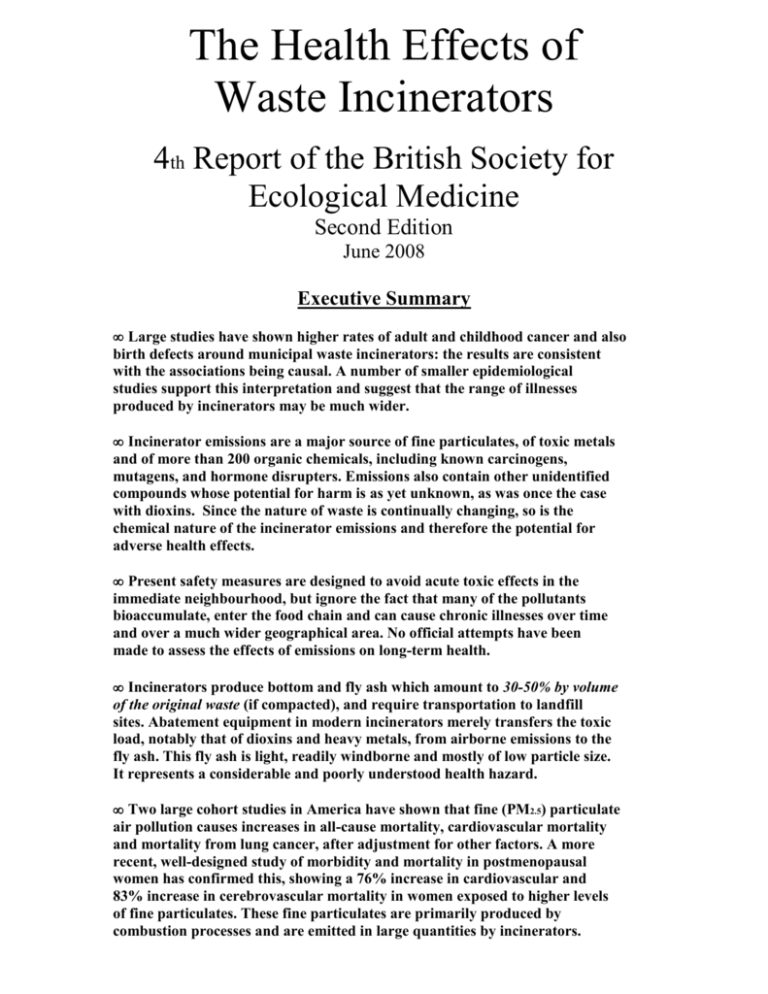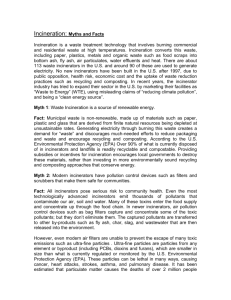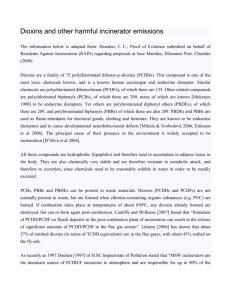Health Report - Executive Summary
advertisement

The Health Effects of Waste Incinerators 4th Report of the British Society for Ecological Medicine Second Edition June 2008 Executive Summary Large studies have shown higher rates of adult and childhood cancer and also birth defects around municipal waste incinerators: the results are consistent with the associations being causal. A number of smaller epidemiological studies support this interpretation and suggest that the range of illnesses produced by incinerators may be much wider. Incinerator emissions are a major source of fine particulates, of toxic metals and of more than 200 organic chemicals, including known carcinogens, mutagens, and hormone disrupters. Emissions also contain other unidentified compounds whose potential for harm is as yet unknown, as was once the case with dioxins. Since the nature of waste is continually changing, so is the chemical nature of the incinerator emissions and therefore the potential for adverse health effects. Present safety measures are designed to avoid acute toxic effects in the immediate neighbourhood, but ignore the fact that many of the pollutants bioaccumulate, enter the food chain and can cause chronic illnesses over time and over a much wider geographical area. No official attempts have been made to assess the effects of emissions on long-term health. Incinerators produce bottom and fly ash which amount to 30-50% by volume of the original waste (if compacted), and require transportation to landfill sites. Abatement equipment in modern incinerators merely transfers the toxic load, notably that of dioxins and heavy metals, from airborne emissions to the fly ash. This fly ash is light, readily windborne and mostly of low particle size. It represents a considerable and poorly understood health hazard. Two large cohort studies in America have shown that fine (PM2.5) particulate air pollution causes increases in all-cause mortality, cardiovascular mortality and mortality from lung cancer, after adjustment for other factors. A more recent, well-designed study of morbidity and mortality in postmenopausal women has confirmed this, showing a 76% increase in cardiovascular and 83% increase in cerebrovascular mortality in women exposed to higher levels of fine particulates. These fine particulates are primarily produced by combustion processes and are emitted in large quantities by incinerators. Higher levels of fine particulates have been associated with an increased prevalence of asthma and COPD. Fine particulates formed in incinerators in the presence of toxic metals and organic toxins (including those known to be carcinogens), adsorb these pollutants and carry them into the blood stream and into the cells of the body. Toxic metals accumulate in the body and have been implicated in a range of emotional and behavioural problems in children including autism, dyslexia, attention deficit and hyperactivity disorder (ADHD), learning difficulties, and delinquency, and in problems in adults including violence, dementia, depression and Parkinson’s disease. Increased rates of autism and learning disabilities have been noted to occur around sites that release mercury into the environment. Toxic metals are universally present in incinerator emissions and present in high concentrations in the fly ash. Susceptibility to chemical pollutants varies, depending on genetic and acquired factors, with the maximum impact being on the foetus. Acute 6 exposure can lead to sensitisation of some individuals, leaving them with lifelong low dose chemical sensitivity. Few chemical combinations have been tested for toxicity, even though synergistic effects have been demonstrated in the majority of cases when this testing has been done. This synergy could greatly increase the toxicity of the pollutants emitted, but this danger has not been assessed. Both cancer and asthma have increased relentlessly along with industrialisation, and cancer rates have been shown to correlate geographically with both toxic waste treatment facilities and the presence of chemical industries, pointing to an urgent need to reduce our exposure. In the UK, some incinerators burn radioactive material producing radioactive particulates. Inhalation allows entry into the body of this radioactive material which can subsequently emit alpha or beta radiation. This type of radiation has low danger outside the body but is highly destructive within. No studies have been done to assess the danger to health of these radioactive emissions. Some chemical pollutants such as polyaromatic hydrocarbons (PAHs) and heavy metals are known to cause genetic changes. This represents not only a risk to present generations but to future generations. Monitoring of incinerators has been unsatisfactory in the lack of rigor, the infrequency of monitoring, the small number of compounds measured, the levels deemed acceptable, and the absence of biological monitoring. Approval of new installations has depended on modelling data, supposed to be scientific measures of safety, even though the method used has no more than a 30% accuracy of predicting pollutants levels correctly and ignores the important problems of secondary particulates and chemical interactions. It has been claimed that modern abatement procedures render the emissions from incinerators safe, but this is impossible to establish and would apply only to emissions generated under standard operating conditions. Of much more concern are non-standard operating conditions including start-up and shut- down when large volumes of pollutants are released within a short period of time. Two of the most hazardous emissions – fine particulates and heavy metals – are relatively resistant to removal. The safety of new incinerator installations cannot be established in advance and, although rigorous independent health monitoring might give rise to suspicions of adverse effects on the foetus and infant within a few years, this type of monitoring has not been put in place, and in the short term would not reach statistical significance for individual installations. Other effects, such as adult cancers, could be delayed for at least ten to twenty years. It would therefore be appropriate to apply the precautionary principle here. There are now alternative methods of dealing with waste which would avoid the main health hazards of incineration, would produce more energy and would be far cheaper in real terms, if the health costs were taken into account. Incinerators presently contravene basic human rights as stated by the United Nations Commission on Human Rights, in particular the Right to Life under the European Human Rights Convention, but also the Stockholm Convention and the Environmental Protection Act of 1990. The foetus, infant and child are most at risk from incinerator emissions: their rights are therefore being ignored and violated, which is not in keeping with the concept of a just society. Nor is the present policy of locating incinerators in deprived areas where their health effects will be maximal: this needs urgent review. Reviewing the literature for the second edition has confirmed our earlier conclusions. Recent research, including that relating to fine and ultrafine particulates, the costs of incineration, together with research investigating nonstandard emissions from incinerators, has demonstrated that the hazards of incineration are greater than previously realised. The accumulated evidence on the health risks of incinerators is simply too strong to ignore and their use cannot be justified now that better, cheaper and far less hazardous methods of waste disposal have become available. We therefore conclude that no more incinerators should be approved.











